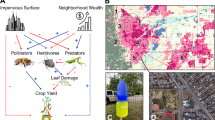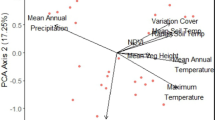Abstract
Social insects can build impressive nest mounds but the functional significance of their architecture is rarely studied in experiments. The ‘magnetic’ termite mounds of monsoonal northern Australia built by Amitermes meridionalis are notable for their elongated wedge shape and north–south axial orientation. We tested whether the shape is an adaptation to facilitate gas exchange and the preservation of food stores by two experimental manipulations of mounds in situ covering all seasons. First, mounds were shaded to limit drying after rain and second, mound shape was amended from wedge to (approximate) sphere. Food storage, fungal contamination, and internal CO2 concentration were unaffected by manipulation, but showed a distinct seasonal dynamic, with storage peaking towards the onset of rains and fungal load towards the end of the rainy season. Internal CO2 concentrations were subject to a diurnal cycle, but also showed elevation during rains. We propose that one advantage of the wedge shape is the efficient use of building effort to achieve good passive ventilation for the food storage areas.





Similar content being viewed by others
References
Darlington J., Zimmerman P.R., Greenberg J., Westberg C. and Bakwin P. 1997. Production of metabolic gases by nests of the termite Macrotermes jeanneli in Kenya. J. Trop. Ecol. 13: 491-510
Darlington J., Zimmerman P.R. and Wandiga S.O. 2009. Populations in nests of the termite Macrotermes jeanneli in Kenya. J. Trop. Ecol. 8: 73-85
Gay F.J. and Calaby J.H. 1970. Termites of the Australian region. In: Biology of Termites (Krishna K. and Weesner F.M., Eds). Academic press, New York, London, pp 393-448
Grassé P.P. 1984. Réparation, reconstruction et remaniements internes du nid. Coordination de tâches individuelles et comportement stigmergique. La déterminisme du comportement constructeur. In: Termitologia, tome ii: Fondation des Sociétés - Construction (Grassé P.P., Ed). Masson, Paris, pp 490-577
Grigg G.C. 1973. Some consequences of the shape and orientation of ‘magnetic’ termite mounds. Aust. J. Zool. 21: 231-237
Hansell M.H. 2005. Animal Architecture. Oxford University Press USA, New York.
Holt J.A. 1998. Microbial activity in the mounds of some Australian termites. Appl. Soil Ecol. 9: 183-187
Jack R.L. 1897. Notes on the ‘meridional ant-hills’ on the Cape York Peninsula. Proc. R. Soc. Queensl. 12: 99-100
Jacklyn P.M. 1991. Evidence for adaptive variation in the orientation of Amitermes (Isoptera: Termitinae) mounds from northern Australia. Aust. J. Zool. 39: 569-577
Jacklyn P.M. 1992. ‘magnetic’ termite mound surfaces are oriented to suit wind and shade conditions. Oecologia 91: 385-395
Jacklyn P.M. and Munro U. 2002. Evidence for the use of magnetic cues in mound construction by the termite Amitermes meridionalis (Isoptera: Termitinae). Aust. J. Zool. 50: 357-368
Korb J. 2003. The shape of compass termite mounds and its biological significance. Insect. Soc. 50: 218-221
Korb J. 2011. Termite mound architecture, from function to construction. In: Biology of Termites: A Modern Synthesis (Bignell D.E., Roisin Y. and Lo N., Eds). Springer, Heidelberg London New York, pp 349-374
Korb J. and Linsenmair K.E. 1998. The effects of temperature on the architecture and distribution of Macrotermes bellicosus (Isoptera: Macrotermitinae) mounds in different habitats of a west African guinea savanna. Insect. Soc. 45: 51-65
Korb J. and Linsenmair K.E. 1999. The architecture of termite mounds: A result of a trade-off between thermoregulation and gas exchange? Behav. Ecol. 10: 312-316
Korb J. and Linsenmair K.E. 2000. Ventilation of termite mounds: New results require a new model. Behav. Ecol. 11: 486-494
Lüscher M. 1961. Air-conditioned termite nests. Sci. Am. 205: 138-145
Ozeki M., Isagi Y., Tsubota H., Jacklyn P. and Bowman D. 2007. Phylogeography of an Australian termite, Amitermes laurensis (Isoptera, Termitidae), with special reference to the variety of mound shapes. Mol. Phylogenet. Evol. 42: 236-247
Rosengaus R.B., Moustakas J.E., Calleri D.V. and Traniello J.F.A. 2003. Nesting ecology and cuticular microbial loads in dampwood (Zootermopsis angusticollis) and drywood termites (Incisitermes minor, I. schwarzi, Cryptotermes cavifrons). J. Insect Sci. 3: 31
Rosengaus R.B., Traniello J.F.A. and Bulmer M.S. 2011. Ecology, behavior and evolution of disease resistance in termites. In: Biology of Termites: A Modern Synthesis (Bignell D.E., Roisin Y. and Lo N., Eds). Springer, Heidelberg London New York, pp 165-191
Ruelle J.E. 1964. L’architecture du nid de Macrotermes natalensis et son sens fonctionnel. In: Etudes sur les Termites Africains (Bouillon A., Ed). Masson, Paris, pp 327-364
Serventy V.N. 1967. Nature Walkabout. Reed AH and AW, Sydney
Spain A.V., Okello-Oloya T. and John R.D. 1983. Orientation of the termitaria of two species of Amitermes (Isoptera: Termitinae) from northern Queensland. Aust. J. Zool. 31: 167-177
Taylor J.A. and Tulloch D.O.N. 2006. Rainfall in the wet-dry tropics: Extreme events at Darwin and similarities between years during the period 1870-1983 inclusive. Austral. Ecol. 10: 281-295
Theraulaz G., Gautrais J., Camazine S. and Deneubourg J.L. 2003. The formation of spatial patterns in social insects: From simple behaviours to complex structures. Phil. Trans. R. Soc. London A 361: 1263-1282
Turner J.S. 2000a. Architecture and morphogenesis in the mound of Macrotermes michaelseni (Sjöstedt) (Isoptera: Termitidae Macrotermitinae) in northern Namibia. Cimbebasia 16: 143-175
Turner J.S. 2000b. The extended organism: The physiology of animal-built structures. In: President and Fellows of Harvard College (Eds). Harvard, USA
Turner J.S. 2001. On the mound of Macrotermes michaelseni as an organ of respiratory gas exchange. Physiol. Biochem. Zool. 74: 798-822
Acknowledgments
We thank Christine Schauer, Phil Hickey, and Craig Hempel for assistance in the field, the members of the School for Environmental Research at the Charles Darwin University for their logistic support and Environment Australia for permission to do field work. We also thank colleagues and the reviewers for helpful comments on the manuscript. This study was supported by a research grant to J. K. provided by the German Science Foundation (KO 1895/7-1).
Author information
Authors and Affiliations
Corresponding author
Electronic supplementary material
Below is the link to the electronic supplementary material.
Rights and permissions
About this article
Cite this article
Schmidt, A.M., Jacklyn, P. & Korb, J. ‘Magnetic’ termite mounds: is their unique shape an adaptation to facilitate gas exchange and improve food storage?. Insect. Soc. 61, 41–49 (2014). https://doi.org/10.1007/s00040-013-0322-6
Received:
Revised:
Accepted:
Published:
Issue Date:
DOI: https://doi.org/10.1007/s00040-013-0322-6




